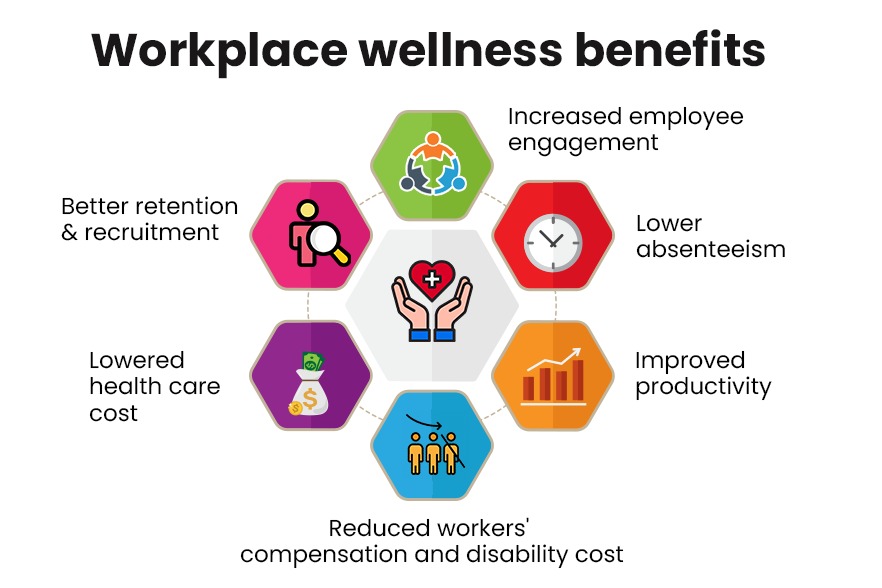These programs go beyond providing gym memberships or fruit baskets; they encompass a holistic approach that addresses a diverse range of employee needs, from stress management to financial literacy. By prioritizing well-being, organizations can cultivate a healthier, happier, and more engaged workforce.

The Multifaceted Benefits of Workplace Wellness:
A comprehensive workplace wellness program delivers a multitude of benefits, impacting both employees and the organization as a whole.
Improved Employee Health: Wellness initiatives can lead to reductions in chronic diseases, lower absenteeism rates, and fewer healthcare claims. Encouraging healthy habits through programs like fitness challenges, nutritional guidance, and smoking cessation support can significantly improve employee well-being.
Enhanced Employee Productivity: When employees feel physically and mentally healthy, they are more focused, energized, and motivated. Wellness programs can boost productivity by reducing stress, improving sleep quality, and enhancing cognitive function.
Lower Healthcare Costs: A healthier workforce translates to lower healthcare expenses for both employees and employers. Wellness programs can help prevent health issues, leading to reduced medical claims and overall healthcare costs.
Increased Employee Engagement and Retention: Employees who feel valued and supported by their employer are more likely to be engaged and committed to their work. Wellness initiatives demonstrate that an organization cares about the holistic well-being of its employees, leading to increased loyalty and reduced turnover.
Improved Company Culture:
A focus on wellness creates a positive and supportive work environment, fostering a sense of community and belonging among employees. This can lead to improved morale, communication, and collaboration.
Implementing Effective Workplace Wellness Initiatives:
Designing and implementing successful workplace wellness programs requires careful planning and consideration.
- Conduct a Needs Assessment:
Gather employee feedback to understand their specific health concerns, wellness goals, and preferred program formats. Tailoring initiatives to meet individual needs is crucial for maximum impact.
Set Realistic Goals and Objectives: Establish clear, measurable, and achievable goals for your program. Start with small, manageable steps and gradually expand initiatives based on employee participation and feedback.
Offer a Variety of Programs: Provide a diverse range of options to cater to different interests and needs. Consider fitness classes, nutrition workshops, mindfulness sessions, stress management training, and financial wellness resources.
Promote Inclusivity and Accessibility: Ensure that all employees have equal access to wellness programs regardless of their physical abilities, health conditions, or personal circumstances.
Encourage Participation and Ownership: Make wellness programs fun, engaging, and rewarding. Encourage peer-to-peer support, team challenges, and recognition for participation.
Measure and Evaluate Results: Track program participation, employee health outcomes, and return on investment. Use data to identify areas for improvement and refine your initiatives over time.
Addressing Common Concerns and Barriers:
Cost: Wellness programs can be perceived as expensive, but the long-term benefits often outweigh the initial investment.
Employee Buy-in: Many employees may be hesitant to participate, especially if they view wellness programs as another work requirement. Emphasize the voluntary nature of programs and the numerous benefits for both individuals and the organization.
Time Constraints: Employees often cite lack of time as a barrier to wellness. Offer flexible program schedules, integrate wellness activities into the workday, and provide resources for time management.
FAQs about Workplace Wellness:
Q: Who should be involved in developing a workplace wellness program?
A: Involve employees from all levels and departments to ensure the program addresses diverse needs and interests.Q: What are some examples of successful wellness programs?
A: Examples include fitness challenges, health screenings, mindfulness classes, ergonomic assessments, smoking cessation programs, and financial wellness workshops.Q: How can I encourage employee participation in wellness programs?
A: Promote the program widely, offer incentives, create a supportive culture, and highlight the benefits of participation.Q: What are the legal considerations when implementing a wellness program?
A: Ensure compliance with relevant laws and regulations, such as the Americans with Disabilities Act and the Genetic Information Nondiscrimination Act.
Conclusion:
Investing in workplace wellness is not just a trend; it’s a strategic imperative for organizations seeking to thrive in today’s competitive landscape. By prioritizing the well-being of their employees, companies can reap significant rewards in terms of improved health, increased productivity, reduced healthcare costs, and a more positive and engaged work environment. While implementing successful wellness programs requires careful planning and ongoing commitment, the benefits far outweigh the challenges.
By embracing a holistic approach to well-being, organizations can create a workplace where employees feel valued, supported, and empowered to thrive both professionally and personally.
Closure
Thus, we hope this article has provided valuable insights into Workplace wellness initiatives. We appreciate your attention to our article. See you in our next article!